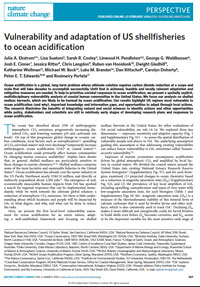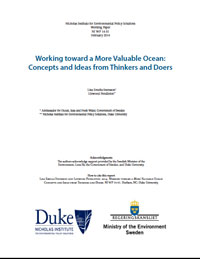Publications
Vulnerability and Adaptation of U.S. Shellfisheries to Ocean Acidification
Ocean acidification is a global, long-term problem whose ultimate solution requires carbon dioxide reduction at a scope and scale that will take decades to accomplish successfully. A new perspective published in Nature Climate Change offers the first nationwide look at the vulnerability of our country’s $1 billion shellfish industry to the global, long-term problem of our oceans becoming more acidic due to the absorption of increasing amounts of carbon dioxide from the atmosphere.
Mangrove Ecosystem Services Valuation: State of the Literature
A growing body of literature provides estimates of ecosystem services values derived from mangroves. If this literature is to be useful in decision making, it must have a solid foundation of value estimates. This paper identifies gaps in data and knowledge regarding mangrove ecosystem services valuations and recommends ways that future research could advance understanding of mangrove ecology, ecosystem services valuation, and conservation.
Transitioning to a New Blue Economy: Proceedings of the December 2013 Economics of the Ocean Summit
Government's role in ocean environmental policy is often viewed as an economic cost to business rather than a boost to the economic value of the sea. But new evidence shows that the new blue economy can improve environmental quality in the ocean while generating new business opportunities. Furthermore, government has a key role to play in making, creating, and catalyzing this new blue economy. In December 2013, the Swedish government and Duke University hosted a meeting at the House of Sweden in Washington D.C. to discuss how innovative policy making and new business approaches together can improve the value and sustainability of the natural capital in our seas and estuaries. Decision makers, “big thinkers,” and practitioners came together for two days to share ideas and to catalyze discussion with a focus on the experiences of the United States and Sweden, two maritime countries that are forging new ocean economies.
Working toward a More Valuable Ocean: Concepts and Ideas from Thinkers and Doers
By better defining the economic values of the services provided by ecosystems and integrating these values in the economy, the world will be better equipped to sustainably use these ecosystems and, in turn, increase their capacity. In December 2013, the Swedish government and Duke University hosted a meeting for decision makers, “big thinkers,” and practitioners to discuss how innovative policy making and new business models can augment the value of natural capital in our seas and estuaries. The forum at the House of Sweden revealed the degree to which businesses, governments, and multinational organizations are tackling the challenge of improving ocean health while enhancing human wellbeing and increasing returns to human enterprise. These short essays highlight keynote remarks from U.S. Assistant Secretary of State Kerri-Ann Jones, Rear Admiral Jonathon White of the U.S. Navy, Catarina Heder of the Swedish Agency for Marine and Water Management, World Bank senior economist Pawan Patil, and others.
Incorporating Ecosystem Services in Marine Planning: The Role of Valuation
This arcticle in the journal Marine Policy scrutinizes the use of ecosystem services valuation for marine planning. Lessons are drawn from the development and use of environmental valuation and cost-benefit analysis for policy making in the United States and the United Kingdom. Current approaches to marine planning in both countries are presented, and the role that ecosystem services valuation could play in this context is outlined. It highlights steps in the marine planning process during which valuation can inform marine planning and policy making as well as discusses methodological challenges to applying ecosystem services valuation techniques to marine planning. Finally, it makes recommendations to meet these challenges.
Ecology: Protect the Deep Sea
Formal governance structures and funds need to be put in place by 2020 to create networks of sea-floor reserves that maintain and restore biodiversity and functioning of deep-sea ecosystems, writes the Nicholas Institute for Environmental Policy Solutions Linwood Pendleton and colleagues in a comment piece in the journal Nature.
More than one million square kilometres of the sea below 200 metres in depth are being ploughed by trawlers, and the next decade will see expansion of oil, gas and mineral extraction into deeper waters. At risk are ecosystems that contain thousands of undiscovered organisms, that contribute to the health and productivity of the ocean, that challenge our ideas of the extremes at which life can exist, and that are habitat and nursery for fisheries. Some threatened species have lifespans of hundreds of thousands of years or live in habitats that take millennia to form. The 2015 U.N. General Assembly should develop a new body to protect deep sea biodiversity, or extend the mandate of the International Seabed Authority (ISA) beyond mining to protect the deep-sea from a wider range of regulated commercial industrial activities, the authors suggest. The ISA could then apply the Convention on Biological Diversity targets for protecting and restoring 10% of the oceans, including the deep sea, by 2020. This conservation activity would require around $30 million per annum, which could be raised by taxing extractions from the deep sea, Pendleton and his co-authors propose.
Deep Sea Minerals and the Green Economy
Deep sea minerals are one of several potential non-renewable resource prospects that offer an opportunity for both resource-endowed countries and the global community to apply transformative policies to ensure future resource development. Mining companies are preparing to explore and extract minerals from the Pacific's seabed with the first commercial sea-floor massive sulphide mining venture on track to start in Papua New Guinea in 2014. In chapter eight, "Deep Sea Minerals and the Green Economy," authors explore five policy design principles that could be considered when evaluating potential development.
Sustainable Economic Development and Deep Sea Mining
Ensuring that deep sea mining will have a positive impact on Pacific Island communities requires supporting not only the economic capital upon which sustainable and resilient economies are built, but also the social and environmental capital. In chapter four, "Sustainable Economic Development and Deep Sea Mining," authors explore the potential benefits and costs of deep sea mining to the economic and environmental capital of coastal and small island developing states in the region. The chapter also looks at traditional and emerging ways to determine the economic, environmental, and social costs and benefits of mining.
Ecological Restoration in the Deep Sea
The deep sea is increasingly recognized as a fertile area for offshore industrialization. If existing activities in the deep sea continue or are expanded and new deep-ocean industries are developed, there is need to consider what is required to minimize repair resulting in damages to the deep-sea environment. This article in the journal Marine Policy develops the discourse on deep-sea restoration and offers guidance on planning and implementing ecological restoration projects for deep-sea ecosystems that are already, or are at threat of becoming degraded, damaged or destroyed. Two deep-sea restoration case studies in Scotland and Papua New Guinea are described and are contrasted with on-going salt marsh restoration in the San Francisco Bay.
Considering “Coastal Carbon” in Existing U.S. Federal Statutes and Policies
Coastal ecosystems such as mangroves, salt marshes, and seagrasses provide important ecosystem services, including nursery habitat for fish, shoreline protection, and the recently recognized service of carbon sequestration and storage. When these wetland ecosystems are degraded or destroyed, the carbon can be released to the atmosphere, where it adds to the concentration of greenhouses gases (GHGs) that contribute to climate change. Yet, no federal statute, regulation, or policy accounts directly for the carbon held in coastal habitats. This article, featured in the journal Coastal Management, identifies key steps for the inclusion of the ecosystem services of coastal habitats into the implementation of existing federal policies without statutory changes; doing so would increase the degree to which these policies consider the full economic and ecological impacts of policy actions.










